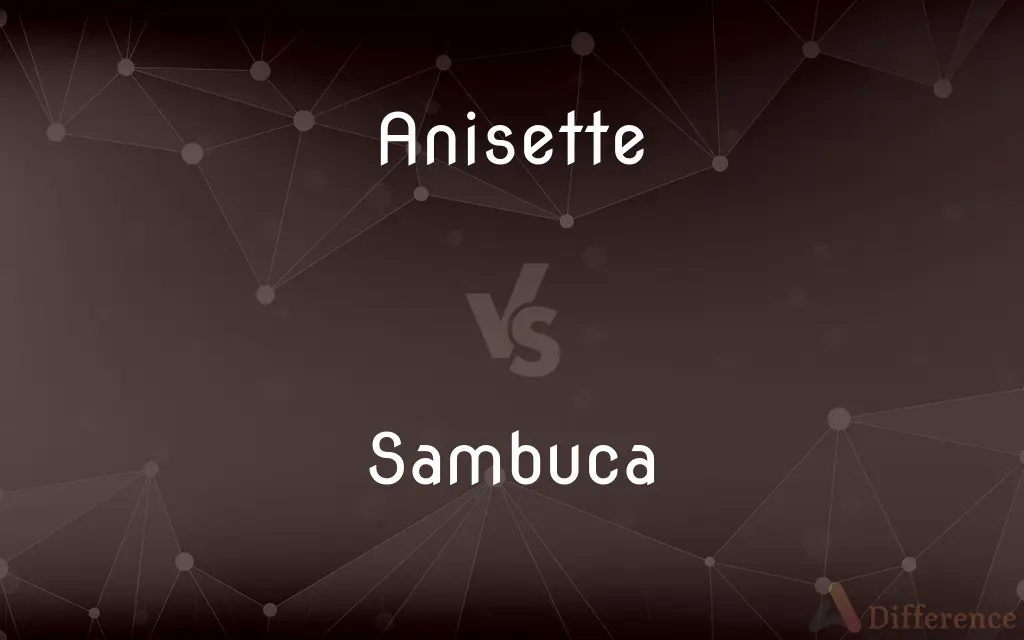Anisette vs. Sambuca — What's the Difference?
By Tayyaba Rehman — Updated on November 2, 2023
Anisette is a sweet French anise-flavored liqueur, lighter in flavor, while Sambuca is an Italian anise-flavored liqueur often served with coffee beans.

Difference Between Anisette and Sambuca
Table of Contents
ADVERTISEMENT
Key Differences
Anisette is a French liqueur derived from anise seeds, delivering a sweet and subtle licorice flavor with a lower alcohol content. Sambuca, in contrast, is an Italian liqueur with a stronger anise flavor and higher alcohol content, traditionally served with three coffee beans representing health, happiness, and prosperity. Both Anisette and Sambuca share the characteristic anise flavor, but they differ in their sweetness, alcohol strength, and cultural serving traditions.
The production of Anisette involves the distillation of aniseed, and the resulting spirit is sweetened with sugar. Sambuca's production is similar, but it may also include essential oils from other spices like star anise, elderflower, and licorice, creating a more complex flavor profile. Anisette is typically enjoyed on its own or in cocktails as a mild, sweet component, whereas Sambuca is often consumed neat, with water, or aflame in the traditional Italian "con la mosca" presentation.
In terms of consumption, Anisette is widely used in culinary applications, from baking to dessert flavoring, given its gentler anise essence. Sambuca, with its potent profile, is less common in cooking but is a staple in Italian social gatherings and is more often enjoyed as a digestif. While both Anisette and Sambuca can be sipped slowly after a meal, Sambuca's boldness makes it more likely to be savored on its own.
Anisette's history dates back to the 18th century in France, with Marie Brizard being one of the first notable brands. Sambuca has a shorter but vibrant history, originating in the early 20th century and gaining fame through the Molinari brand post-World War II. Anisette has a cultural connection to French cafes and patisseries, while Sambuca is deeply rooted in Italian cafe culture and post-meal rituals.
Finally, Anisette is often lighter in color, sometimes nearly transparent, and lower in alcohol by volume, typically between 25-35%. Sambuca usually has a higher alcohol content, around 38-42% by volume, and can range from colorless to deep blue or red, depending on the additional flavorings used. Both liqueurs have earned their place in the world of spirits, with Anisette being favored for a milder taste and Sambuca for those seeking a robust anise kick.
ADVERTISEMENT
Comparison Chart
Origin
France
Italy
Flavor Intensity
Sweeter and subtler
Stronger anise flavor
Alcohol Content
25-35% ABV
38-42% ABV
Serving Tradition
Enjoyed on its own or in cocktails
Often served neat with coffee beans or aflame
Color
Lighter, usually clear
Can be colorless or colored (blue, red)
Compare with Definitions
Anisette
Used in various culinary dishes, especially desserts
The recipe called for Anisette to flavor the cake.
Sambuca
Used in both drinking and flambe presentations
For a dramatic effect, the bartender flamed the Sambuca.
Anisette
Often served as a cordial for its sweet and mild taste
After dinner, they shared a bottle of Anisette.
Sambuca
Commonly consumed as a digestif in Italian culture
Our host presented us with Sambuca to finish our feast.
Anisette
Consumed as a digestif in French cuisine
We concluded the meal with a glass of Anisette.
Sambuca
An Italian anise-flavored liqueur typically served with coffee beans
He ordered a Sambuca with three coffee beans for good luck.
Anisette
A sweet French liqueur flavored with anise
She added a splash of Anisette to her coffee for extra flavor.
Sambuca
Enriched with essential oils and spices for a complex taste
The Sambuca had a rich, layered flavor profile.
Anisette
A liqueur with a light herbal note from anise seeds
The herbal aroma of Anisette was quite soothing.
Sambuca
Part of traditional Italian drinking rituals
Sambuca is essential in the Italian tradition of 'con la mosca'.
Anisette
Anisette, or Anis, is an anise-flavored liqueur that is consumed in most Mediterranean countries, mainly in Malta, Spain, Italy, Portugal, Turkey, Greece, Albania, Lebanon, Cyprus, Israel, Palestine, and France. It is colorless, and because it contains sugar, is sweeter than dry anise flavoured spirits (e.g.
Sambuca
Sambuca (Italian pronunciation: [samˈbuːka]) is an Italian anise-flavoured, usually colourless, liqueur. Its most common variety is often referred to as white sambuca to differentiate it from other varieties that are deep blue in colour (black sambuca) or bright red (red sambuca).
Anisette
A liqueur flavoured with aniseed.
Sambuca
An Italian aniseed-flavoured liqueur
A glass of flaming sambuca
A good few sambucas were consumed before he finally tottered into a taxi
Anisette
A liqueur flavored with anise.
Sambuca
An ancient triangular stringed instrument.
Anisette
A French alcoholic liqueur flavored with anise
Sambuca
An Italian liqueur with the flavor of anise.
Anisette
A French cordial or liqueur flavored with anise seeds.
Sambuca
An Italian liqueur made from elderberries and flavoured with licorice, traditionally served with 3 coffee beans that represent health, wealth and fortune (or past, present and future).
Anisette
Liquorice-flavored usually colorless sweet liqueur made from aniseed
Sambuca
(musical instruments) An ancient form of triangular harp having a very sharp, shrill tone.
Sambuca
An ancient type of ship-borne siege engine.
Sambuca
An Italian liqueur made with elderberries and flavored with licorice
Common Curiosities
Is Sambuca used in culinary recipes?
Sambuca is less common in cooking but can be used in desserts and flambéing.
How is Anisette traditionally served?
Anisette is typically served neat, on ice, or mixed in cocktails.
What is the traditional way to serve Sambuca?
Sambuca is traditionally served neat with three coffee beans, or "con la mosca," and sometimes flamed.
Is Anisette or Sambuca better for cocktails?
Anisette is often preferred in cocktails for its sweeter, more subtle flavor.
What is Sambuca?
Sambuca is a sweet, anise-flavored Italian liqueur, often higher in alcohol content than Anisette.
Is Anisette high in alcohol?
Anisette has a moderate alcohol content, usually between 25-35% ABV.
What is Anisette?
Anisette is a sweet, anise-flavored liqueur from France, known for its gentle licorice taste.
Can Anisette be used in cooking?
Yes, Anisette is commonly used in dessert recipes and as a flavor enhancer in various dishes.
What does "con la mosca" mean in the context of Sambuca?
"Con la mosca" means "with the fly," referring to the tradition of serving Sambuca with three coffee beans.
Are Anisette and Sambuca suitable for vegetarians?
Generally, yes, both Anisette and Sambuca are suitable for vegetarians, but one should always check the brand for specific ingredients.
What type of anise is used in Anisette?
Anisette is made from anise seeds, which give it a licorice flavor.
Does Sambuca contain real coffee beans?
Traditional Sambuca is served with actual coffee beans, which are meant to be chewed while drinking.
What are the primary flavors in Anisette and Sambuca?
Both Anisette and Sambuca have anise as their primary flavor, though Sambuca may include other spices.
Can you drink Sambuca straight?
Yes, Sambuca is often enjoyed straight, especially as a digestif.
Is Sambuca stronger than Anisette?
Yes, Sambuca typically has a higher alcohol content, around 38-42% ABV.
Share Your Discovery

Previous Comparison
Hmm vs. Umm
Next Comparison
Billion vs. QuintillionAuthor Spotlight
Written by
Tayyaba RehmanTayyaba Rehman is a distinguished writer, currently serving as a primary contributor to askdifference.com. As a researcher in semantics and etymology, Tayyaba's passion for the complexity of languages and their distinctions has found a perfect home on the platform. Tayyaba delves into the intricacies of language, distinguishing between commonly confused words and phrases, thereby providing clarity for readers worldwide.














































